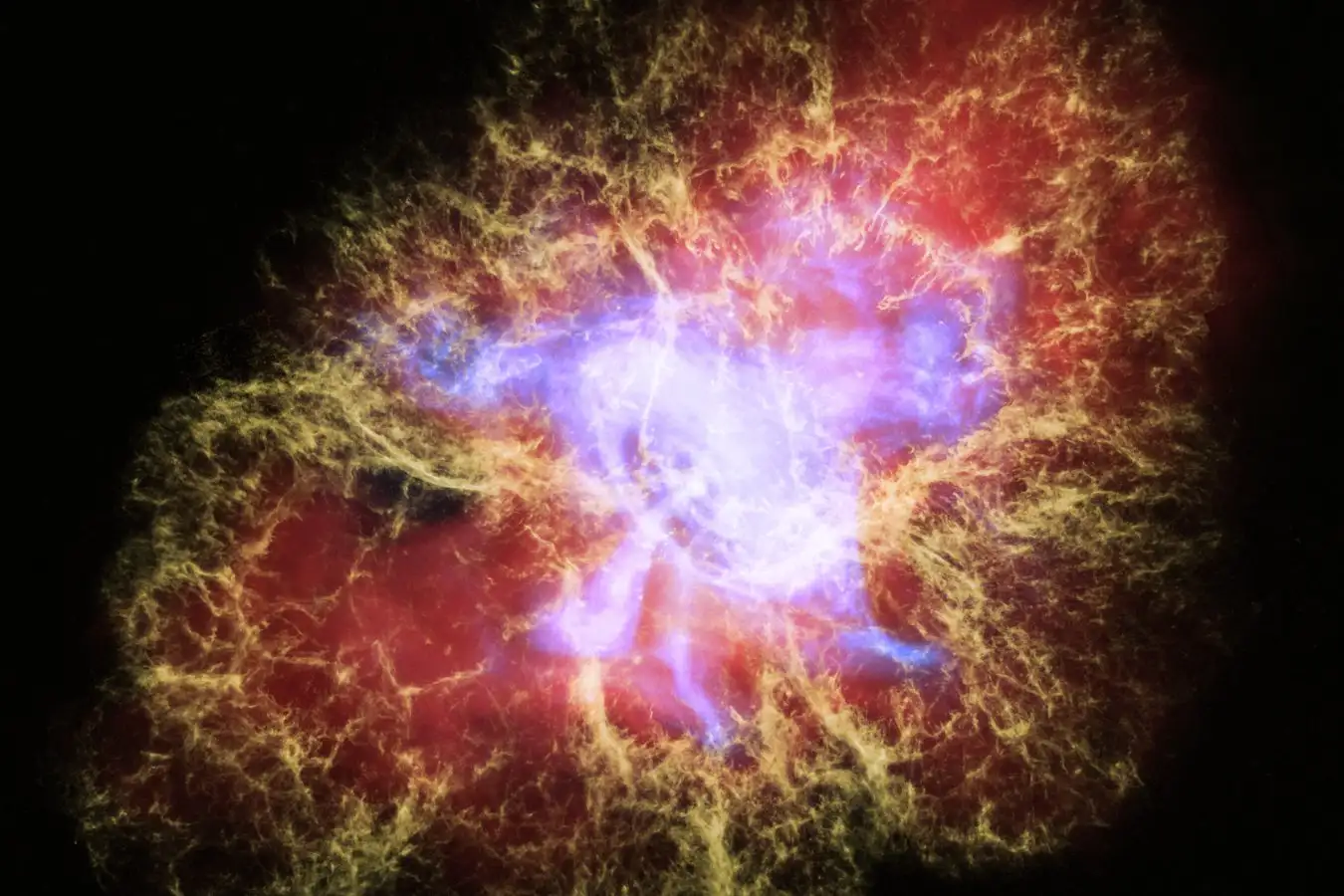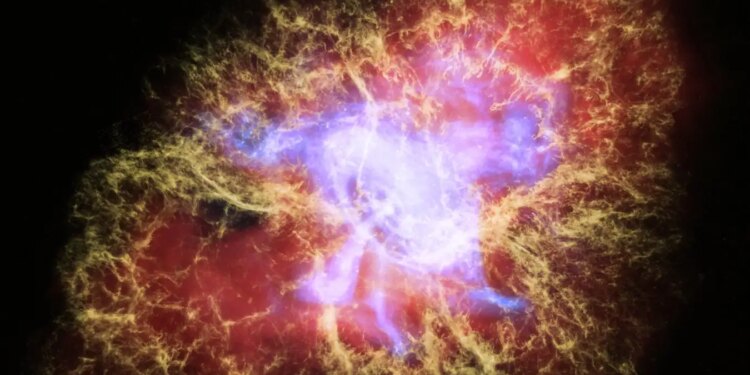
Where did the speed of light come from and why is it so stubborn?
NASA, ESA, CXC, SSC
The following is an extract from our Lost in Space-Time newsletter. Each month, we dive into fascinating ideas from around the universe. You can sign up for Lost in Space-Time here.
If you’ve taken a university-level physics class, you’ll have “fond” memories of being asked to measure the speed of light and – if, over several hours, you managed to line up your mirrors and lenses and light source just right – getting an answer just under 300 million metres per second. It is a foundational constant in physics, one that’s crucial to understand if you want to learn anything at all about the universe.
When we look out into the cosmos, light is our only resource – well, not quite our only one, but gravitational waves are fairly limited in what they can show us right now, so please forgive the slight exaggeration. Practically every breakthrough in astronomy and cosmology is based on collecting light that has travelled millions or billions of years from the edges of reality. Even the light from the very nearest star to our solar system has travelled for more than four years to reach us. The time light takes to travel may be among the most useful – and least intuitive – parts of physics.
People have been arguing about the speed of light since long before we had any idea what light actually was. For centuries, many of the brightest minds thought that light was actually emitted from your eye like a sort of lantern, in part because of how some animals’ eyes glow at certain angles in the dark. Despite that, they still argued about whether light was transmitted instantaneously or took time to travel, and this wasn’t properly tested until the 17th century.
The earliest attempts at quantifying it involved setting up a lantern some distance from an observer and measuring the difference in time between the lantern being opened and the observer seeing its light. That didn’t work (Galileo and his contemporaries couldn’t get a conclusive measurement because the observers were too close to the lanterns), and eventually scientists moved on to more complex and precise methods. The first one that actually worked came around in 1675, when Ole Rømer was working on measuring the orbital period of Jupiter’s moon Io. Rømer noticed the period seemed to change as the distance between Earth and Jupiter shifted over time, which didn’t make sense at all – why would Io’s orbit have anything to do with Earth’s position? In fact, it only appeared different because of the time light takes to travel from Io to Earth, which is shorter when the two are closer together. One of his colleagues, Christiaan Huygens, did the maths and found the speed of light was about 220,000,000 metres per second. This wasn’t quite right, partially because we didn’t know the details of Earth’s motions yet, but it is in the ballpark, and the estimates got better from there as scientists developed more precise measurement techniques. By the mid-18th century, measured values were within a few per cent of the currently accepted number of 299,792,458 metres per second for the speed of light in a vacuum.
That brings up two questions: why is the speed of light such a random number, and why is there a speed limit at all? The first is easy to answer: it has to do with our units, because metres and seconds (or miles and hours, or whatever everyday units you care to use) were first defined in terms of the human experience of the world – a mile was a thousand steps, for example – which had nothing to do with fundamental constants. The second is more complicated, and it has to do with special relativity.
We’ll find our answer in perhaps the most famous equation ever written: e=mc2. This has a lot of implications, but at its basest level, it means we can think of energy and mass as interchangeable. When objects are moving at extraordinarily high, or relativistic, speeds, I like to think of them as just having a momentum, which is a combination of their mass and velocity. If you want to speed an object up, you have to keep pouring more and more energy into it. A massive object moving at the speed of light would have infinite momentum, which you can think of as infinite energy or infinite mass. That’s simply not possible: by the time the object got close to the speed of light, its mass would become so enormous that it’d be impossible to accelerate it further. But light doesn’t have mass, so it easily sidesteps this problem.
Special relativity also means an outside stationary observer would see something truly wacky if they were watching this. When an object is moving at relativistic speed, from the outside, time appears to slow down for that object. If I was moving away from you at 99 per cent the speed of light, you would see my ageing slow down. This is called time dilation. The other bit is called length contraction – if I was flying away from you head-first, Superman-style, you’d also see me get shorter and shorter as I got faster. From my speedy reference frame, I wouldn’t feel time slowing or myself shrinking, but from the outside, the closer I got to the speed of light, the shorter and more ageless I would become.
That’s a problem, because if I ever reached the speed of light, an observer from the outside would see time totally stop for me as my height reached zero. I’d blip out of existence, along with the space-time travelling with me. Luckily for me, the laws of physics don’t allow that. The only things that can reach that speed limit are massless: photons, gluons, the effects of gravity and that’s about it. Nothing can travel through space-time faster.
Instead of being frustrated by this cosmic speed limit, we can rejoice, because the speed of light has one very important consequence: the entire idea of consequences. All of physics, our entire understanding of everything, is based on a foundation of causality, the idea that effect always follows cause and never the other way around.
Think about it this way: as I approach the speed of light, you observe time slowing down for me. If I reached the speed of light, it would stop. And if I kept going even faster, it would start going in the opposite direction. By travelling faster than the speed of light, as observed from your reference frame, I would be moving backward in time. If I sent you a signal that travelled faster than the speed of light, like some sort of physics-defying magical text message, you’d get it before I sent it. Without our universal speed limit, it would be impossible to tell which event caused what effect – everything about the universe would be pretty much incomprehensible.
That leads me to my final point, one that I find both mind-blowing and fun to contemplate. If every signal takes time to travel, and time moves differently in reference frames that are travelling at different speeds with respect to one another, what does it mean for two events to take place “at the same time”? If I wink at myself in the mirror, the wink I see reflected back actually happens just a tiny slice of time later than the wink that I physically did, because the light had to bounce off my face, then the mirror, then come back to my eyes to perceive. If you say that two events at different locations in space occurred at the same time, I have to ask, “according to whom?”. Depending on the distance between the two locations, it’s possible that for one observer, Event 1 will have happened first, and for another, Event 2 will have preceded Event 1. There’s no such thing as objective simultaneity – no such thing as “the same time” – and all because light has a speed. Wild, right?
Topics:
Source link : https://www.newscientist.com/article/2501889-the-fascinating-story-of-the-ultimate-cosmic-law/?utm_campaign=RSS%7CNSNS&utm_source=NSNS&utm_medium=RSS&utm_content=home
Author :
Publish date : 2025-11-04 18:00:00
Copyright for syndicated content belongs to the linked Source.





